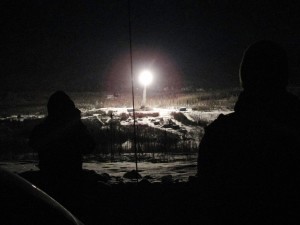Rocket launches from Poker Flat Research Range
January 31, 2011

907-474-7468
1/31/11
Scientists launched a NASA sounding rocket at 1:49 a.m. on Friday, Jan. 28, achieving their goal of gathering an image of the Whirlpool Galaxy from a rocket that arced about 150 miles above northern Alaska.
“We were on target,” said professor Jim Green of the University of Colorado, who led the launch team. “It behaved exactly the way we thought it should.”
During the rocket mission, which lasted about 15 minutes from the time the two-stage rocket launched until the payload landed by parachute about 170 miles north, researchers used an electronic telescope to capture an ultraviolet image of the Whirlpool Galaxy, 31 million light years from Earth. The team needed to move the rocket slightly while it was en route to point its telescope directly at the galaxy. They pulled off the maneuver and are optimistic they gathered the information they sought.
“We had five minutes of good data,” Green said. “It’s all on a tape and we’ll burn it on a CD and bring it back to Colorado to make an image. … We want to find where the most recent and active star formation is in this galaxy.”
The successful science mission launched from Poker Flat Research Range, operated by the University of Alaska Fairbanks Geophysical Institute under contract to NASA. The University of Colorado research team at the range included graduate student Brennan Gantner, who celebrated the successful launch with his wife, parents and best friend, all of whom had traveled to Alaska to watch the culmination of about seven years work. Gantner also celebrated his 34th birthday on the morning of the launch.
“I’m thrilled and relaxed at the same time,” Gantner said after the launch, as he stood arm-in-arm with his wife, Kim Winges. “We had a lot of people working on this. I’m so thankful.”
A video of the launch is posted at http://bit.ly/PFRR2011-1.
The launch is the first of two scheduled for January to February at Poker Flat Research Range. Next up is a similar two-stage NASA sounding rocket that a team, including Scott Bailey of Virginia Tech, will use to measure nitric oxide, a molecule that destroys ozone, from about 30 to 100 miles above the ground. That rocket is set to launch about Feb. 1.
Geophysical Institute personnel from Poker Flat will retrieve the instruments from both missions with a helicopter. A team from Poker Flat flew out in a fixed wing plane the morning of Jan. 28 to locate the payload from the University of Colorado mission and mark it with GPS.
While the public is not permitted on Poker Flat Research Range during rocket launches, people may view rocket launches and activity from several vantage points near the range.
Poker Flat Research Range is the largest land-based sounding rocket range in the world. It’s located 30 miles north of Fairbanks on the Steese Highway. More than 300 major scientific sounding rockets have launched from the facility since it was founded in 1969.
ADDITIONAL CONTACTS: Poker Flat Research Range at 907-455-2110. Marmian Grimes, UAF public information officer, at 907-474-7902 or via e-mail at marmian.grimes@alaska.edu.
ON THE WEB: http://www.gi.alaska.edu/pfrr
NOTE TO EDITORS: A photo is available for download at www.uafnews.com.
NR/1-31-11/136-11


